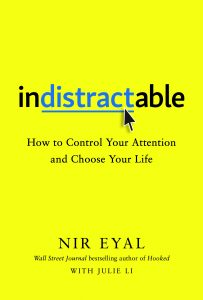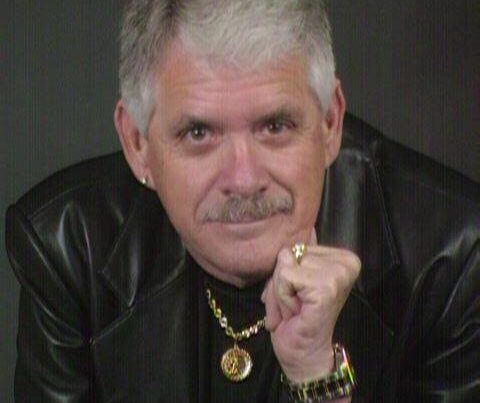Podcast: Play in new window | Download
Subscribe: RSS
What triggers cause us to become distracted and how do we transform them so we can gain traction towards our goals and desires?

Nir Eyal
Nir Eyal writes, consults, and teaches about the intersection of psychology, technology, and business. The M.I.T. Technology Review dubbed him, “The Prophet of Habit-Forming Technology.”
Nir founded two tech companies since 2003 and has taught at the Stanford Graduate School of Business and the Hasso Plattner Institute of Design at Stanford. He is the author of the Wall Street Journal bestselling book, Hooked: How to Build Habit-Forming Products and his latest book, Indistractable: How to Control Your Attention and Choose Your Life
In addition to blogging at NirAndFar.com, Nir’s writing has been featured in The Harvard Business Review, TechCrunch, and Psychology Today. He’s an active investor in habit-forming technologies. Some of his past investments include Eventbrite (NYSE:EB), Refresh.io (acquired by LinkedIn), Worklife (acquired by Cisco), Product Hunt, Marco Polo, Presence Learning, 7 Cups, Pana, Kahoot!, Byte Foods, FocusMate, and Anchor.fm (acquired by Spotify). Nir attended The Stanford Graduate School of Business and Emory University.
In today’s conversation with us, Nir debunks several myths about distraction and explains the truth behind why we get distracted and how to deal with it. We explore our internal and external triggers, the seat of human motivation, how to use your calendar and to-do list effectively, and how to build confidence in your ability to do what you say you want to do, so you can choose your life.
Key Takeaways
- Getting rid of technology is not the answer.
- Without getting to the root cause of why we get distracted, we will always find something to distract ourselves.
- Distraction is not a new problem. Plato talked about it 2500 years before the iPhone.
- The opposite of distraction is not focus. The opposite of distraction is traction.
- Traction is any action that pulls you towards what you want to do. Distraction is any action that pulls you away from what you plan to do.
- Anything can be a distraction and anything can be traction.
- Checking email while you should be working on that big project is pernicious because distraction has tricked you into prioritizing the urgent at the expense of the important.
- As long as you plan what you want to do with your time – you do things according to your values and your schedule – there’s nothing wrong with going on Facebook, watching a YouTube video, or playing a video game.
- When you become indistractable – when you say you’re going to do something and you actually do it – you are reinforcing a behavior pattern that says to yourself, “I am indistractable, I do what I say I’m going to do”, and that is incredibly powerful.
- The root cause of distraction is not the external triggers but in fact the internal triggers. Most distraction does not start from outside of us, but rather from within.
- The reason we tend to become distracted is because we are trying to escape an uncomfortable emotional state.
- Everything we do is about the desire to escape discomfort; even the pursuit of pleasurable responses.
- Time management is pain management. The root cause of the problem is our inability to deal with these uncomfortable emotional states in a healthier way that leads us towards traction rather than distraction.
- Reimagine the internal trigger that you are trying to escape, so you can respond differently and utilize it to lead you towards traction rather than distraction.
- Reimagine your temperament to see yourself differently so you don’t use your identity or false notions of your temperament or disposition to lead you astray.
- Most of the labels that people carry around with them are not really based on science.
- The myth of ego depletion says that you run out of willpower – that it’s a limited resource. Studies show that it is not true, except with people who believe that willpower is a limited resource.
- The #1 distraction in the workplace is colleagues interrupting us with superfluous meetings, interruptions and constant distractions, especially in open floor plan offices.
- When it comes to distraction, a lot of people fall into one of two categories – the blamers and the shamers. The blamers blame the outside stuff. The shamers shame themselves.
- Happiness is a fleeting sensation. Our species has evolved by constantly wanting more, hunting, striving, inventing and creating.
- Feeling bad is not bad. It’s part of the human experience. It’s how we handle feeling bad that matters. Pain is inevitable, suffering is optional. You can channel the discomfort towards traction rather than distraction. To drive you forward as opposed to pulling you back.
- If you can catch yourself the moment before you do that distraction, write down what is the sensation you’re feeling. This instantly gives you a sense of agency and control over that feeling.
- Then explore that sensation with curiosity rather than contempt. Be a claimer. It’s not your fault; it’s your responsibility. You can control how you respond to those feelings.
- Surf the urge using the 10 minute rule. Tell yourself, “I can give in to that distraction. In ten minutes.” During the 10 minutes, surf the urge. Talk to yourself like you would a good friend who might be struggling with this same problem. 9 times out of 10, after ten minutes you’ll be back to the task at hand.
- 25% of the emails that the average knowledge worker sends, they didn’t need to send, and 25% of the email they receive, they didn’t need to receive.
- Often we check our email instead of doing the task at hand, because we are grasping for agency and control.
- Make time for traction. Every person interviewed for the book who struggled with distraction had lots of white space in their calendar.
- Two-thirds of people don’t keep a calendar. The one-third that do only keep a calendar for their work tasks.
- Most people don’t use a to-do list correctly. A to-do list is a list of all the output (rather than outcomes).
- Make a template for your week so that you know the difference for every minute of the day – what is traction and what is distraction. And put time for the fun stuff.
Resources 
- Indistractable: How to Control Your Attention and Choose Your Life
- Hooked: How to Build Habit-Forming Products
Connect With Nir Eyal
- Website: indistractable.com
- Blog: https://www.nirandfar.com
- LinkedIn: https://www.linkedin.com/in/nireyal
- Instagram: https://www.instagram.com/neyal99
- Twitter: https://twitter.com/nireyal
- Facebook: https://www.facebook.com/nirandfar
Did You Enjoy The Podcast?
If you like this episode let us know! Reviews for the podcast on iTunes are greatly appreciated. This helps us reach more entrepreneurs seeking to make a positive impact in the world. If you received value from this episode, it would mean so much if you could take a moment and leave your 5-star rating and review. You can do that by visiting here. Thank you! Together we can make a difference!










